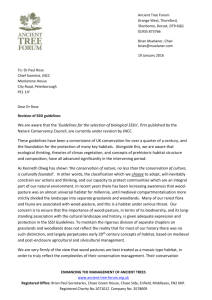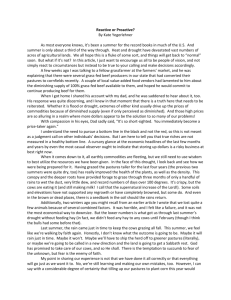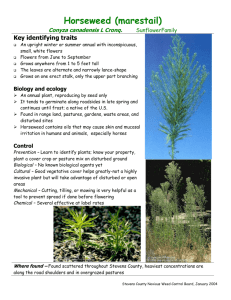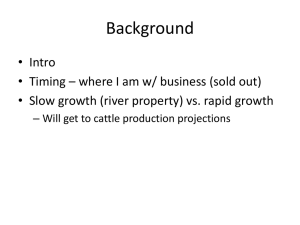of Small Mammal Response to the Introduction Cattle
advertisement
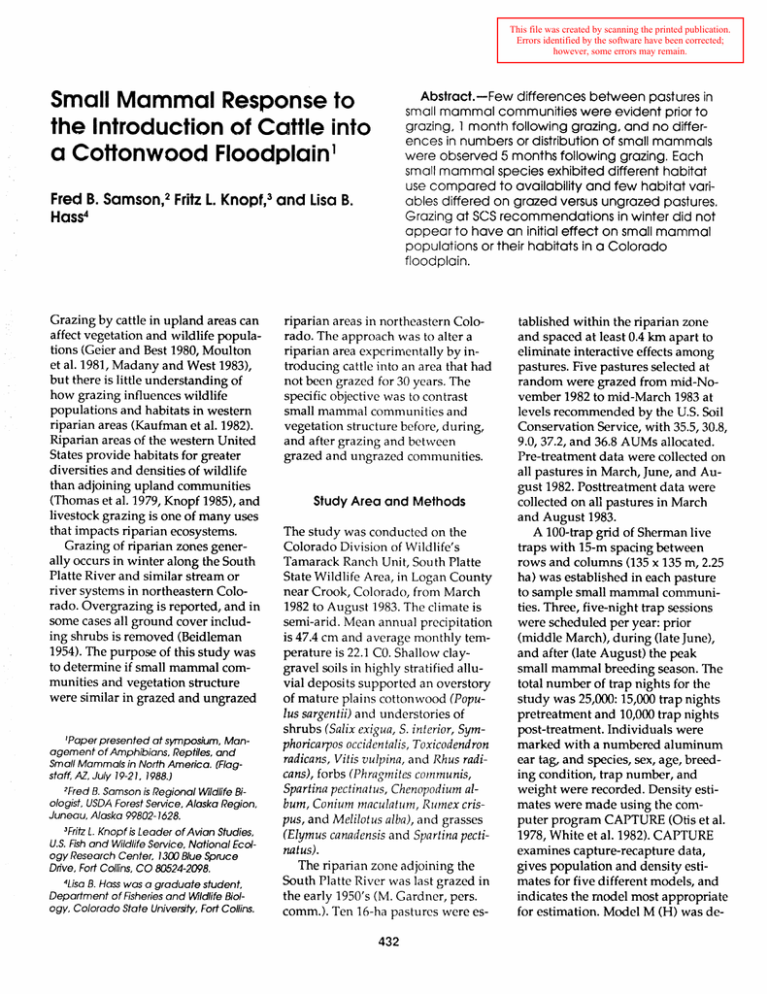
This file was created by scanning the printed publication. Errors identified by the software have been corrected; however, some errors may remain. Small Mammal Response to the Introduction of Cattle into a Cottonwood Floodplain1 Fred 8. S a r n s ~ nFritz , ~ 1. Knopf,l and Lisa 5. Grazing by cattle in upland areas can affect vegetation and wildlife populations (Geier and Best 1980, Moulton et al. 1981, Madany and West 1983), but there is little understanding of how grazing influences wildlife populations and habitats in western riparian areas (Kaufman et al. 1982). Riparian areas of the western United States provide habitats for greater diversities and densities of wildlife than adjoining upland communities (Thomas et al. 1979, Knopf 1985),and livestock grazing is one of many uses that impacts riparian ecosystems. Grazing of riparian zones generally occurs in winter along the South Platte River and similar stream or river systems in northeastern Colorado. Overgrazing is reported, and in some cases all ground cover including shrubs is removed (Beidleman 1954). The purpose of this study was to determine if small mammal communities and vegetation structure were similar in grazed and ungrazed 'Paper presented at symposium, Management of Amphibians, Reptiles, and Small Mammals in North America. (Flagstaff,AZ,July 19-21, 1988.1 Tred 8. Samson is Regional Wildlife Biologist, USDA Forest Service, Alaska Region, Juneau, Alaska 99802- 1628. Vrilz I. Knopf is Leader of Avian Studies, US. Fish and WildlifeService, National Ecdogy Research Center, 1300 Blue Spruce Drive, Forf Collins, CO 80524-2098. 4LisaB. Hass was a graduate student, Department of Fisheries and Wildlife Biology, Colorado State University, Fort Collins. Abstract.-Few differences between pastures in small mammal communities were evident ~ r i oto rgrazing, 1 month following grazing. and no differences in numbers or distribution of small mammals were observed 5 months following grazing. Each small mammal species exhibited different habitat use compared to availability and few habitat varia bles differed on grazed versus ungrazed pastures. Grazing at SCS recommendations in winter did not appear to have an initial effect on small mammal populations or their habitats in a Colorado floodplain. riparian areas in northeastern Colorado. The approach was to alter a riparian area expcrimentally by introducing cattle into an area that had not been grazed for 30 years. The specific objective was to contrast small mammal communities and vegetation structure before, during, and after grazing and between grazed and ungrazed communities. Study Area and Methods The study was conducted on the Colorado Division of Wildlife's Tamarack Ranch Unit, South Platte State Wildlife Area, in Logan County near Crook, Colorado, from March 1982 to August 1983. The climate is semi-arid. Mean annual precipitation is 47.4 cm and average monthly temperature is 22.1 CO. Shallow claygravel soils in highly stratified alluvial deposits supported an overstory of mature plains cottonwood (Popu2us sargentii) and understories of shrubs (Salix exigua, S. interior, Symphoricarpos occidcntalis, Toxicodendron radicans, Vitis vulpina, and Rhus radicand, forbs (Phragrnitcs cornrnunis, Spartina pectinatus, Chenopodium album, Coniurn maculaturn, Rurnex crispus, and Melilotus alba), and grasses (Elyrnus canadensis and Spartina pectinatus). The riparian zone adjoining the South Platte River was last grazed in the early 1950's (M. Gardner, pers. comm.). Ten 16-ha pastures were es- I - - tablished within the riparian zone and spaced at least 0.4 km apart to eliminate interactive effects among pastures. Five pastures selected at random were grazed from mid-November 1982 to mid-March 1983 at levels recommended by the U.S. Soil Conservation Service, with 35.5,30.8, 9.0,37.2, and 36.8 AUMs allocated. Pretreatment data were collected on all pastures in March, June, and August 1982. Posttreatment data were collected on all pastures in March and August 1983. A 100-trap grid of Sherman live traps with 15-m spacing between rows and columns (135 x 135 m, 2.25 ha) was established in each pasture to sample small mammal communities. Three, five-night trap sessions were scheduled per year: prior (middle March), during (late June), and after (late August) the peak small mammal breeding season. The total number of trap nights for the study was 25,000: 15,000 trap nights pretreatment and 10,000 trap nights post-treatment. Individuals were marked with a numbered aluminum ear tag, and species, sex, age, breeding condition, trap number, and weight were recorded. Density estimates were made using the computer program CAPTURE (Otis et al. 1978, White et al. 1982).CAPTURE examines capture-recapture data, gives population and density estimates for five different models, and indicates the rnodel most appropriate for estimation. Model M (H) was de- termined to be the most robust of the five estimators. For each of the five trap sessions, trap sites were categorized according to trap success (no-capture vs. capture) and to the species captured at that site. In March 1982, five no-capture sites and five sites for each species were selected at random for vegetation sampling within each pasture. Beginning in June 1982 and thereafter, the sample size per pasture was increased to ten no-capture sites and ten capture sites for each species. Habitat variables were measured using two line intercept transects 5-m in length at each selected trap site. Variables included percentage cover of sand, litter, grass, forb, and shrub along the 5-m transect. Transects were centered on the trap site and oriented toward randomly chosen cardinal compass directions (north, south, east, or west). The linear intercept of each variable with the transect was measured with an incremental tape. Two additional measurements at each trap site were distance-to-nearest-understory (c10 m) and distance-to-nearest-overstory (>I0 m). Vegetation sampling occurred concurrently or immediately following each trap session. Chi-square tests were used to test for pretreatment differences in species composition among those pastures chosen for grazing and those chosen for controls. Chi-square tests were also used to evaluate posttreatment data. A t-test was performed to examine differences in mean body weight between treatment groups. T-tests were used to compare habitat variables between species and between species-specific capture sites from all other trap locations. In each season, the vegetation variables associated with the capture sites of a species were compared to the pooled sample of vegetation variables consisting of no-cap ture sites in addition to sites for all other species (Dueser and Shugart 1978).The degree of habitat specificity was indicated by the number of variables for which the species sample differed from the pooled sample. Following the species-specific and pooled sample twogroup comparison, mean vegetation values associated with each species were compared on grazed and control pastures using t-tests. These procedures determined whether habitat used by a specific species differed from the average habitat available and compared a species habitat use on control and grazed areas regardless of habitat availability. Some overlap in use of trap sites was observed, thus the pooled sample is not expected to be completely distinct from the species specific sample (Dueser and Shugart 1978). All statistical tests and density estimates were performed using the Statistical Package for the Social Sciences (Nie et al. 1975). Results Species Composition Nine species of small mammals were captured in 1982 and 1983 (table 1). The deer mouse (Peromyscus maniculatus) was the most abundant species, with the western harvest mouse (Reithrodontomys megalotis), kangaroo rat (Dipodomys ordii), prairie vole (Microtus ochogaster), house mouse (Mus musculus), hispid pocket mouse (Perognathus histius), northern grasshopper mouse (Onychomys leucogaster), masked shrew (Sorex cinereus), and spotted skunk (Spilogale putorius) comprising less than 2 % of the 9,304 captures. Pretreatment species richness did not differ among grazed versus ungrazed in March 1982 (X2 = 2.47, P = 0.650) but significant were evident in June (X2 = 15.39, P = 0.017) and August (X2 = 33.18,P = 0.001) (table 1). The differences in June and August were caused by the abundance of kangaroo rats, prairie voles, and house mice on control pastures. While three species-the hispid pocket mouse, masked shrew, and spotted skunk-were found only on pastures to be grazed. Number of captures of the two common species, the deer mouse and western harvest mouse, were not different in June (X2 = 1.71, P = 0.187) or August (X2 = 2.97, P =0.091)between pastures to be grazed and control pastures. Following nearly 4 months of grazing, the composition of small mammal communities in control versus grazed pastures differed in March 1983 (X2 = 15.9, P = 0.001) (table 1) but not in August (X2= 6.05, P = 0.109). The kangaroo rat was not captured on treated pastures in March or August 1983 although present in two of five pastures prior to treatment in 1982. The number of harvest mice captured in grazed pastures increased markedly from March 1982 to March 1983 (19 vs. 45) in contrast to control pastures (39 vs. 40). Inundation of all pastures in MayJuly 1983 (see Knopf and Sedgwick 1987)appeared to influence species distributions and abundances in August. From March to August captures of deer mice on all pastures declined from 611 to 259, western harvest mouse from 85 to 12, and kangaroo rats and mask shrews were no longer captured. Densities and Population Structures Only the deer mouse was captured in sufficient numbers to calculate densities accurately. Deer mice densities were consistently higher on grazed pastures before and after treatment (table 2). However, the density of deer mice decreased 18.7%from preto posttreatment on the five control pastures (x= 33.6/ha vs. x=27.3/ha) versus 42.9% on the five treated pastures (63.2/ha vs. 36.1/ha) for the same interval. Age ratios appear unaffected by grazing (table 2). In contrast, sex ratios in deer mice shifted significantly following grazing (X2 = 4.90, P = 0.049) with three of five grazed pastures having substantially more males. Western harvest mice sex ratios also changed following grazing, with a higher percentage of females captured, but sample sizes were insufficient for separate tests on each of the 10 pastures. The percentage of female deer mice in breeding condition was similar on all pastures prior to grazing except in June 1982, when a higher percentage of females (X2 = 3.84, P = 0.049) were in breeding condition on control pastures. Following grazing, the percentage of breeding females was higher in March (X2 = 5.53, P = 0.019) on control pastures yet grazed pastures had a higher percentage of breeding females (X2 = 5.44, P = 0.020) in August 1983. No significant differences in the percentage of breeding males or females between treatment groups was observed for the other species. Deer mice body weights were similar across pastures prior to grazing, except in June (t = 3.18, P = 0.002). After treatment, mean body weights for mature (subadult plus adult) deer mice were significantly less (t = 2.66, P = 0.008) on grazed pastures (18.56 2 0.18g) than on ungrazed pastures (19.3 2 0.21 g) when data from all replicates were combined. The divergence in mean deer mouse body weight between control and grazed pastures continued into August 1983 (t =3.02, P = 0.003). Species Habitat Use Only sample sizes for the deer mouse, western harvest mouse, prairie vole, and kangaroo rat were suffi- cient for subsequent analysis. Habitat use by deer mice differed from that available in 34% (12/35) of the t tests on control pastures and 12% (4/35) of the tests on grazed pastures over all seasons (table 3). Deer mice were most frequently associated with a lower percentage of grass cover and litter as well as presence of shrubs. A1though habitat near deer mouse capture sites differed from that available, habitat use was similar on control and grazed pastures. Among those habitat variables associated with the deer mouse, 66.7% (2/3) in March 1982,100%(2/2) in June 1982, 66.7% (2/3) in August 1982,80% (41 5) in March 1983, and 0% (0/5) in August 1983 were similar on control and grazed pastures. Like deer mice, the harvest mouse used habitats differing from those available and preferred similar sites on control and grazed pastures (table 4). Thirty-four percent (12/35) of the tests on control pastures and 37% (13/25) of the tests on grazed pastures were significantly different whereas the majority (68%, 13/19) had similar values on control and grazed pastures. The occurrence of harvest mice was most strongly associated with a high percentage of litter and grass cover and a low percentage of sand around the capture site. Prairie vole capture sites differed from the average available site for only 11% (4/35) of the habitat comparisons on control pastures and 17% (6/35) of the habitat comparisons on grazed pastures (table 5). Prairie vole habitat was similar to habitat used by western harvest mouse, as both exhibited a preference for sites with a high percentage of litter. For vegetation variables which were significantly different on prairie vole c a p ture sites compared to the pooled sample of sites, 88% (7/9) had similar values on control and grazed pastures. Kangaroo rats exhibited the highest habitat specificity among the four major mammal species (table 6). Habitat variables from kangaroo rat capture sites differed from the pooled sample of sites for 64% (IS/ 28) of the habitat comparisons on control pastures and 50% (7/14) of the comparisons on pastures to be grazed. The factors which appeared most critical in determining the distribution of kangaroo rats was the high percentage of sand, moderately high percentage of forbs, and low percentages of litter and grass. Discussion and Conclusions Kaufman et al. (1982) in Oregon noted that small mammal densities decreased just following grazing only to increase to pre-grazing levels within a year. Riparian grazing in Oregon, as in most western rangelands, is often in late spring to early fall. A similar pattern, however, is evident following winter grazing in a riparian area in northeastern Colorado with few detectable differences observed in small mammal community 5 months following grazing. The elimination of kangaroo rats from grazed areas appears to be a consequence of grazing although they were never really abundant on pastures to be grazed (table 1). In sandhill rangeland of eastern Colorado, Green (1969) found the density of kangaroo rats approximately the same on ungrazed and grazed pastures. Kangaroo rats may not have colonized riparian grazed pastures because of a change in microhabitat prior to, or unrelated to, cattle introduction. Regardless, the riparian zone appeared to be a marginal habitat for this upland species. Differences in age ratios appear unrelated to grazing. Abramsky (1976) found that juvenile deer mice d o not readily enter traps and, thus, may be under represented in ageclass ratios. The Trivers-Willard hypothesis suggests that a population under stress will produce an increased proportion of females (Myers 1978).The imbalance in deer mouse scx ratios observed in this study on grazed, but not control pastures, does not appear to be related to change in primary sex ratio or survival of young as suggested by the above hypotheses. Rather, most animals captured in March 1983 trap session were adults, 70% of which were tagged in 1982. The mean body weight of deer mice on grazed pastures following treatment was lower than on control pastures. A more parsirnonius hypothesis for the observed shift in sex ratio is emigration of females. Bowers and Smith (1979) found that female deer mice inhabit more mesic microhabi tats than males. Grazing by cattle may have altered microhabi tats preferred by females and or other resources, particularly seeds, may have been more abundant on control areas. There is substantial evidence in other studies that deer mouse populations are limi tcd by seasonal food availability (Gashwiller 1979),specifically in winter (Taitt 1981). Small mammal habitat use and seasonal habitat shifts were similar on grazed and control pastures. Each species illustrated differential habitat use compared to availability, and patterns in habitat use were little affccted by grazing. Deer mice habitat, largely areas with little grass cover, was consistently distinguishable from that of othcr species as reported elsewhere (Bowers and Smith 1979, Kantak 1983, Lovell 1983). Habitat use and number of captures of the western harvest mouse, prairie vole, and kangaroo rat reported in this study are also consistent with that previously documented. The western harvest mouse is reported to be closely associated with grassy sites (Hill and Hubbard 1943, Lovell 1983) and use of sandy sites by kangaroo rats was noted by Green (1969). The importance of vegetative cover to the prairie vole has been well documented (Birney et al. 1976, Green 1969). In summary, research reported in this paper was conducted in an experimental framework, with five replications, to evaluate the initial effects of cattle grazing in winter on small mammal community in a riparian area. Winter grazing of riparian areas based on Soil Conservation Service recommended levels appears to have little initial effect on small mammal populations and their habitats. The study further indicates that pretreatmen t assessment of habitat and small mammal populations in studies to evaluate effects of grazing in riparian areas is important. Significant differences in small mammal numbers and species-specific habitat use observed following grazing could have been attributed to treatment without knowledge of pretreatment population and habitat conditions. Acknowledgments The study was partially funded by the U.S. Fish and Wildlife Service through the Colorado Cooperative Wildlife Research Unit, and is a product of Cooperative Agreement No. 2463-4 between the Colorado Division of Wildlife and the U.S. Fish and,Wildlife Service's National Ecology Research Center. Birney, Elmer D., William E. Grant, and Duane D. Baird. 1976. Importance of vegetative cover to cycles of Microtus populations. Ecology 57: 1043-1051. Bowers, Michael A., and Howard O. Smith. 1979. Differential habitat utilization by sexes of the deermouse, Peromyscus maniculatus. Ecology 60: 869-875. Dueser, Raymond D. and Herman H. Shugart, Jr. 1978. Microhabitats in a forest floor small mammal fauna. Ecology 59: 89-98. Gashwiller, Jay S. 1979. Deer mouse reproduction and its relationship to the tree seed crop. American Midland ~ a t u r a l i s102: t 95-102. Geier, Arnold R., and Louis B. Best. 1980. Habitat selection by small mammals of riparian communi- Literature Cited Abramsky, Z. Z. 1976. Small mammal studies in natural and manipulated shortgrass prairie. Ph. D. dissertation, Colorado State University, Fort Collins. Beidleman, Richard G. 1954. The cottonwood river-bottom community as a vertebrate habitat. Ph.D. dissertation, University of Colorado, Boulder, Colorado. Grazed Disto3 Control Grazed Distu4 Control Grazed 5.3 17.3 22.5 5.8' 14.1 15.61.210.6 10.9 5.8 14.0 2.4 1.8 4,012 0.2' 5h2 20.6 23.0 2.4 12.4 15.0 95.7' 3.2 2.7 7.5 12.8 - - 'Significont (P< 0.05) differencebetween the prairie vole and pooled sample. 2Significant (P< 0.05) difference between grazed and control pastures. Distance to nearest overstory (> IOm). 4Disfanceto nearest understory C< lorn). ties: Evaluating effects of habitat alterations. Journal of Wildlife Management 44: 16-24. Green, N. E. 1969. Occurrence of small mammals on sandhill rangelands in eastern Colorado. M.S. thesis, Colorado State University, Fort Collins. Hill, John E. and Claude W. Hubbard. 1943. Ecological differentiation between two harvest mice (Reithrodontomys) in western Kansas. Journal of Mammalogy 24: 2225. Kantak, Gail E. 1983. Behavioral, seed preference and habitat selection experiments with two sympatic Peromyscus species. American Midland Naturalist 109: 246-252. Kaufman, J. Boone, William C. Krueger, and M. Vavra. 1982. Impacts of a late seasonal grazing scheme on nongame wildlife habitat in a Wallowa Mountain riparian ecosystem. p. 208-220. In Wildlife-livestock Relationships Symposium. Coeur d'Alene, Id., [April 21-22,19811 University of Idaho Forest, Wildlife, and Range Experiment Station, Moscow, Idaho. Knopf, Fritz L. 1985. Significance of riparian vegetation to breeding birds across an altitudinal cline. p. 105-111. In Riparian ecosystems and their management: Reconciling conflicting uses. [Tucson, Ariz., April 16-18,19851 USDA Forest Service General Technical Report RM-120, Rocky Mountain Forest and Range Experiment Station, Fort Collins, Colo. Knopf, Fritz L. and James. A. Sedgwick. 1987. La tent Population responses to a catastrophic, climatological event. Condor 89: 869873. Lovell, David C. 1983. Succession of mammals, and associations of small mammals, in disturbed habitats at Barr Lake State Park, A d a m County, Colorado. M.S. thesis. For Hays State University, Fort Hays, Kan. Madany, Michael H., and Neil E. West. 1983. Livestock grazing-fire regime interactions within montane forests of Zion National Park, Utah. Ecology 64: 661-667. Moul ton, Michael P., Jerry R. Choate, Stephen J. Bissell, and Robert A. Nicholson. 1981. Associations of small mammals on the central high plains of eastern Colorado. Southwestern Naturalist 26: 53-57. Myers, Judith H. 1978. Sex ration adjustment under food stress: Maximiza tion of quality of numbers of offspring? American Naturalist 112: 381-388. Nie, Norman H., C. Hadlei Hull, Jean G. Jenkins, Karin Steinbrenner, and Dale H. Bent. 1975. Statistical Package for the Social Sciences, McGraw-Hill Book Company, New York, NY. Otis, David L., Kenneth P. Burnham, Gary C. White, and David R. Anderson. 1978. Statistical inference from capture data on closed animal populations. Wildlife Monograph 62: 1-135. Taitt, M. J. 1981. The effect of extra food in small mammal populations. I. Deermice (Perornyscus rnaniculatus). Journal of animal ecology 50: 111-124. Thomas, Jack W., Chris Maser, and Jon E. Rodick. 1979. Riparian zones. In Wildlife habitats in managed forests, the Blue Mountains of Oregon and Washington, USDA Handbook 553: 40-47. White, Gary C., David R. Anderson, Kenneth P. Burnham, and David L. Otis. 1982. Capture-recapture and removal methods for sampling closed populations. Los Alamos National Laboratories, Los Alamos, NM. Zimrnerman, Earl G. 1965. A comparison of habitat and food of two species of Microtus. Journal Mammalogy 46: 605-612.
